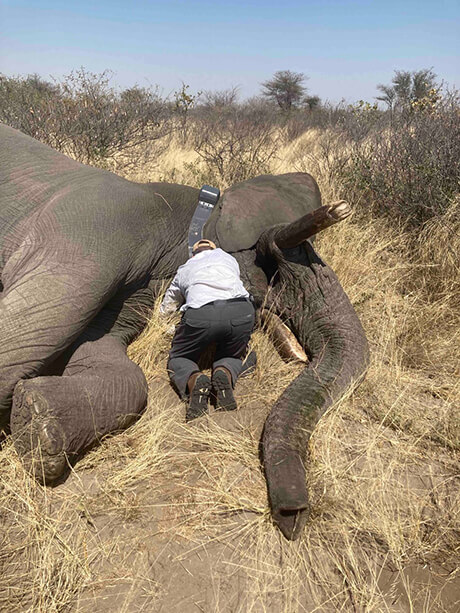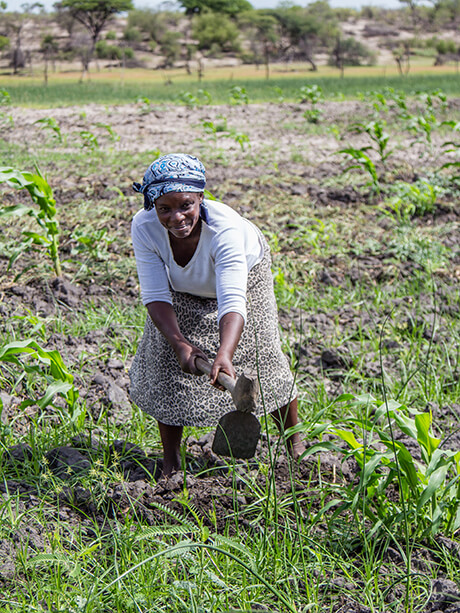Late this August or early in September, at approximately the same time AZA members gather for the 2022 national conference in Baltimore, a veterinarian working with the non-profit Elephants for Africa (EfA) will strap in at the open door of a helicopter with a tranquilizer gun and take off through Botswana’s vast Makgadikgadi Pans National Park in search of elephant bulls.
Transient males account for 99% of Makgadikgadi’s elephant population. But, because the park is vast with very little infrastructure, no one knows for sure where these non-resident animals spend the bulk of their time as they travel through. That makes them vulnerable to poaching. And, it’s not the only concern.
The region already has some of the highest rates of human-elephant conflict in Botswana and, in recent years, elephants have extended the southern edge of their range into the Kalahari and even the capital, Gaborone, further increasing the likelihood of human interaction.
When the darting team is finished, 10 males will be outfitted with satellite trackers as part of important new research by EfA to understand the likely movement patterns of African savannah elephants in Botswana.


Dr Kate Evans, Founder & Director, Elephants for Africa and Member of the Gothenburg Global Biodiversity Centre, hopes this data provides valuable insight that government agencies and NGOs can use to better balance the needs of wildlife and humans as they expand into each other’s habitats.
The three-year project is supported by four AZA-accredited organizations, Jacksonville Zoo and Gardens, Maryland Zoo, Milwaukee County Zoo, and Memphis Zoo.
“As every AZA member will affirm, the work we do in zoos and aquariums is especially important when we put it in the context of protecting wild habitats,” said Maryland Zoo President & CEO, Kirby Fowler. “We’ve had a great working relationship with EfA and feel this new research will answer key questions about African savannah elephant movement.”
Outfitting the Elephants
The helicopter and a team on the ground will focus on an area in the southwest of the park. Data has shown that, on average, males spend about a month and a half in the study area.
Aiming for the rump, the vet will dart a fast-acting sedative at a selected bull. It takes about five minutes to kick in, at which point the ground team goes quickly to work. Time is of the essence.
As they approach the elephant, the team makes sure it’s resting on its side. If the animal settles on its sternum, an antidote is given immediately. Otherwise, lactic acid builds up, potentially creating what’s known as white muscle disease, from which the animal can’t recover.
Once on its side, the animal is kept cool with water and shade. The veterinarian, now on the ground, joins the team to monitor breathing and make sure the trunk is open. Blood, fecal samples, and body measurements are taken. Members of the team then place a collar on the elephant which is affixed at the top with the data collector and transmitter. A counterweight at the bottom ensures the transmitter stays in the proper position to connect with the monitoring satellite.
The whole operation takes about fifteen minutes after which the antidote is given and the team retreats to a safe distance. The animal will groggily awaken in two to three minutes before getting on with its day.
A Call to Action
Dr. Evans founded Elephants for Africa specifically to understand the social and ecology requirements of male elephants. Her work has since expanded, applying this work to a human landscape to alleviate human-elephant conflict. Since 2007, she has built a team of Botswana citizens who conduct research on this unique elephant population, run Environment Clubs with students in local schools, and work with local communities to improve human-wildlife coexistence.
This work is becoming ever more important as climate change, human population growth, and the unsustainable use of natural resources increase pressure across Botswana ecosystems.
“Historically, what happened in Botswana is that elephants and other wildlife were pretty much pushed into the Okavango Delta in the north of the country,” away from human activity, Evans said.
“What we’re dealing with now, is that you have rural communities, subsistence farmers, trying desperately to farm in an area which is fundamentally a desert. So, it’s not highly productive, and people, more and more, are competing with wildlife for resources,” especially in areas that receive little rain.
“You have communities that haven’t had to deal with elephants and other wildlife for one or two generations,” Evans said. “That cultural knowledge about what to do when encountering an elephant, or protecting livelihoods is missing.”
Understanding the where and the why of elephant movements will make it easier to predict when a bull may move through farms or villages. It will also help local officials determine where human improvements, like fencing along the Boteti river, may affect elephant crossings.
“We really need to know where these males are going, how they’re getting across this community land and, ultimately, why they’re going into these areas which seemingly don’t have a lot of resources for them,” Evans said.


What’s Behind the Migration?
The northern area of Makgadikgadi can be lush and green at certain times of the year. So why is the elephant population increasingly expanding southwards into semi-desert environments where food and water are more scarce?
To unpack what could be happening, Evens recalls an observation she first made two decades ago.
“All the way back in 2002, I noticed that a lot of Botswanan elephant tusks were chipped or broken. They also tend to be short and thick, unlike the big tuskers you see in South Africa and East Africa where tusks can almost touch the ground.”
Evans wondered, “Well, maybe the tusks are breaking because there are mineral deficiencies like calcium, phosphorus, and selenium, which contribute heavily to bone and tusk formation?”
“That 2002 observation always stuck with me. The bells really began ringing as we noticed elephants moving into these southern, more arid areas.”
What’s going on is “probably a combination of push-me, pull-you,” Evans said.
“The elephants are being pushed because of human population growth and immigration of elephants from neighbouring countries, as well as ecological changes up in the north. But what’s pulling them and where are they likely to go?” Evans queried. “Could it be set in minerals and nutritional requirements, which is making them go into these areas which they haven’t been to for so long?”
In a brief about the project, EfA writes, “Little is known about the role of dietary needs for specific minerals in finer-scale movements across the landscape, although there are multiple examples of elephants specifically targeting plant parts according to their mineral content, clearly indicating the need to regulate their mineral intake.”
This is why the team will collect soil, water, and plant samples in addition to the animal samples. Using inductively-coupled plasma mass spectrometry analysis, the team will assess the mineral concentration in elephant feces and all environmental samples, specifically focusing on calcium, phosphorus, and selenium.
This data will be overlaid with GIS data to see if there are linkages between the spatial distribution of elephants and the concentrations of minerals in the soil, water, and vegetation.
As the author, Annie Dillard once wrote, “We must somehow take a wider view, look at the whole landscape, really see it, and describe what’s going on here.” Which is why, in addition to understanding elephant movements, ultimately, EfA hopes that the findings of the study will be applied to increase food security and income diversity for the human communities that border the vast Makgadikgadi park.
“AZA institutions have supported our work for a number of years, not just financially through regular donations, but also through access to their experts and data from their elephants, which helped us develop our program and ensure that our beneficiaries are extended beyond Botswana,” Evans said.
 BACK TO STORIES
BACK TO STORIES
 MORE ZOOGRAM STORIES
MORE ZOOGRAM STORIES